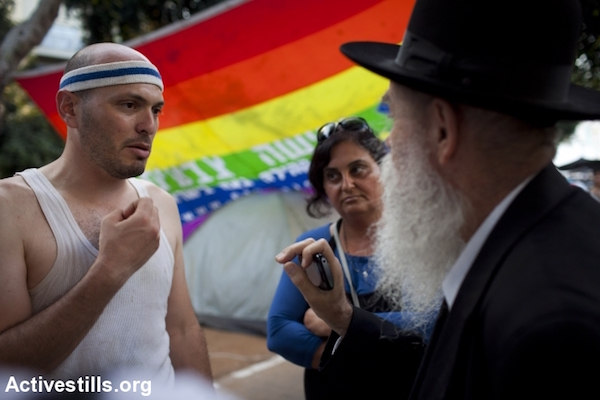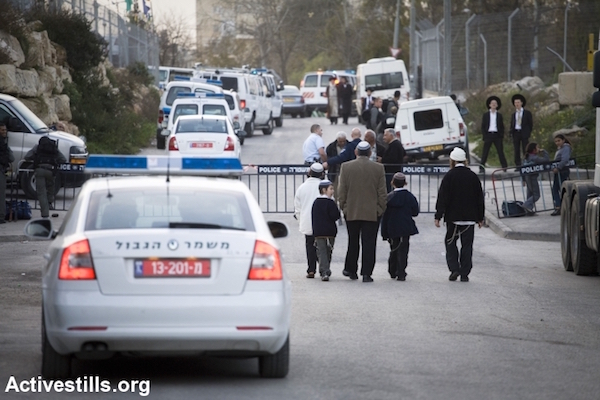The religious-secular chasm may be kept at a low boil beneath the unifying factor of the Israel-Palestinian conflict. But more likely, the polarization is one reason why Israel does not take more action to end the conflict.

A recent and vast survey of Israelis by the Pew Research Center showed deep divisions of attitudes within Israeli society. Much of the attention centered on the finding of highly opposed views “not only between Israeli Jews and the country’s Arab minority, but also among the religious subgroups that make up Israeli Jewry,” as Pew’s own Facebook description read.
The survey offers many valuable findings, but the fact that Jews hold profoundly different attitudes based on how observant they are is the least original among them. Among Jews, the level of religious observance (secular, traditional, Orthodox and ultra-Orthodox self-definition) has long explained the most enduring and irreconcilable differences in Israeli Jewish political opinions. It predicts whether an Israeli Jew holds left, center or right-wing attitudes more than any other demographic — this has been true during my own 17 years of polling and all earlier data I know of.
Common perceptions that upper-class people are more left wing, or that Mizrahi and Ashkenazi ethnic background determines whether someone is right or left, respectively, are not totally wrong. But these factors are far weaker and less consistent predictors than religious observance. Isolating either education or income leads to poor correlation with ideology. While there are some broad left-and-right trends among clearly defined Ashkenazim and Mizrahim, those identities are increasingly mixed up after generations of immigration and intermarriage. Measurements vary, but in our own +972 Magazine survey, about 40 percent of Israelis self-identify as neither one – just “Israeli.” Moreover, former Soviet immigrants are largely Ashkenazi, but also largely right wing.
By contrast, the religious-secular split looms large in all data sets. What does this mean in practice?
Secular Jews consistently self-identify as left wing at higher rates — about 32 percent in a poll I conducted for the Foundation for Middle East Peace (FMEP), higher than the national average of 20 percent among Jews and over 10 times more than the three percent among national-religious respondents. Over 80 percent of the latter call themselves right wing. Those ideological labels are the most direct determinant of voting behavior.
On conflict-related policy, seculars invariably support a two-state solution — about three-quarters in a survey I conducted for J Street in 2014, and over half of traditional respondents. Nearly 70 percent of Orthodox respondents rejected it. The FMEP survey showed that two-thirds of secular Jews thought settlements harm Israel’s legitimacy and security, while 87 percent of national-religious disagreed.
On religion and state questions, the 2015 Israel Democracy Index observed that 100 percent of ultra-Orthodox prioritize the Jewish rather than democratic characteristics of Israel, while a majority of seculars prefer democracy – calling the findings “unsurprising.”

The now-infamous 48 percent in the Pew survey who support “expelling Arabs” downplays this division: in fact, 38 percent among seculars support the idea, with a 60 percent majority opposed; among traditional or “masorti” the data is practically flipped (54 percent agree and 39 percent disagree). Over 70 percent of the religious support such an expulsion, and nearly 60 percent of ultra-Orthodox (Haredim).
Support for right-wing positions related to the conflict is often somewhat lower among the ultra-Orthodox, some of whom reject Zionism or just bow out of public affairs. But as seen above, their trends are still closer to the Orthodox than to secular attitudes on those issues – and far more stringent, of course, on religion and state questions.
The vastly opposing worldviews affect how politicians relate to those constituencies. And since Israel’s policy overwhelmingly reflects Jewish society, even if Jewish and Arab attitudes are more opposed, the religious-secular divide is more influential in political life. Small religious parties are almost always key to forming a majority coalition. That gives them disproportionate political power for their population size (just under one-fifth of the Israeli public).
Religious polarization is among the reasons why Israel does not take more action to end the conflict. Resistance to Israeli concessions is so stiff among the religious communities and most politicians won’t risk angering them. Or leaders may use them as an excuse to justify why concessions are impossible.
The Pew finding may be routine, but that in no way lowers its value. Knowing that this is our deepest divide should spark a frank conversation about the fact that Israel will see no internal peace and no relief on the Israeli-Palestinian front until these tensions are addressed.
What can be done? On the civic level, secular, religious, Jews, and Arab/Palestinian citizens (to mention only the most deeply divided groups) – must confront the need to declare, once and for all, the common shared basis for society. The ground rules of that society must be equality and secular institutions, freedom of and from religion in the public sphere. All sides will have to make mature compromises.

Religious people must commit to the privatization of religious belief and practice, and be satisfied with Jewish symbols in a mainly secular state, such as a Star of David on the flag, or a Jewish calendar. Moderate religious Jews must speak up to empower like-minded people in their communities, to counter fanaticism and coercion.
Secular Jews also need to step up and end the contempt for religious people that can be heard, in order to connect to religious communities willing to build something together. I believe this anger emerges from the often-corrosive role religion plays in Israeli political life, but partnerships are more important now than complaints.
Haredim must accept that freedom of religion happens in the home, and that nothing gives them the right to impose their minority religious interpretations in any civic, public space.
Finally, politicians must decide which direction determines policy on the conflict. One vision draws on a range of tangible incentives and evidence, all pointing toward the conclusion that political independence for Palestinians, freedom of livelihood and human rights will benefit all sides on multiple levels. The other vision clings to prophecies, tribal dominance, unseen deities, and democracy-be-damned. Only the latter can possibly justify relentless territorial expansion and suffocation of Palestinian livelihood. I can see no other moral, legal, or even self-interested justification. The daily violence and accelerating pace of wars have gutted any argument that Israel’s current policies somehow serve its security.
But unless Israelis declare common values for a society based on freedom of and from religion, and take the messiah out of calculations on the conflict, we can expect to see ever-deepening attitudinal rifts among Israelis – with less and less hope for solutions.


